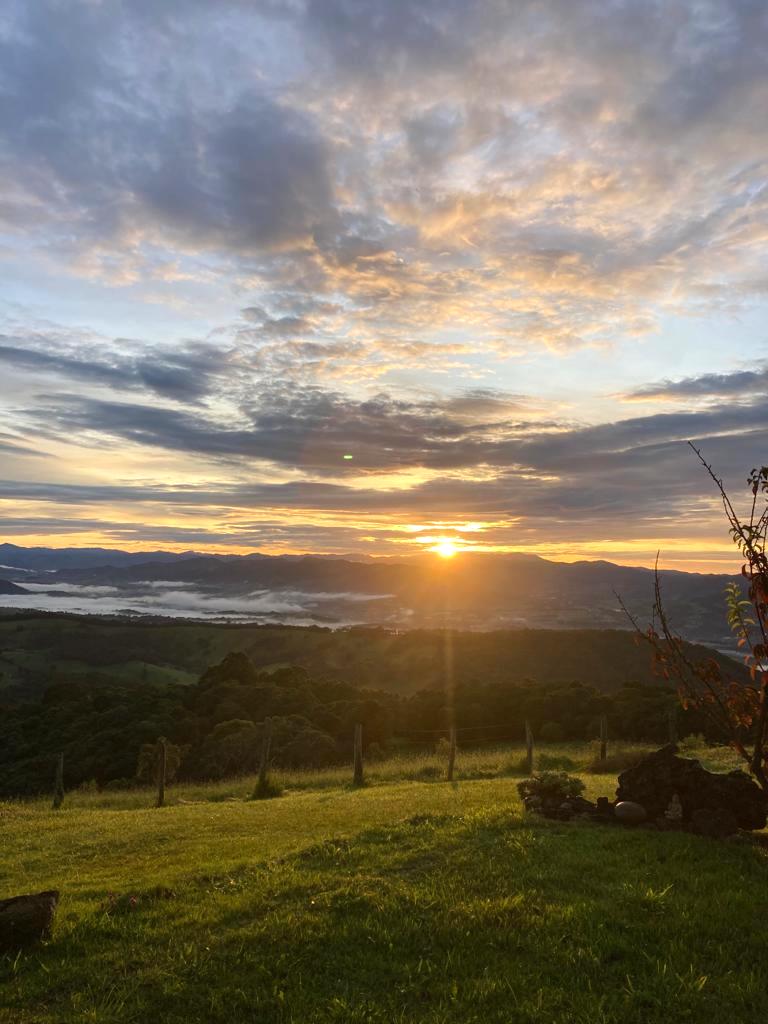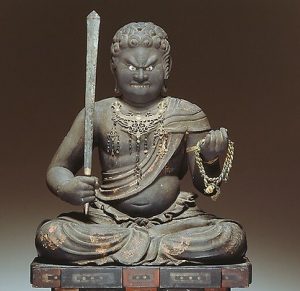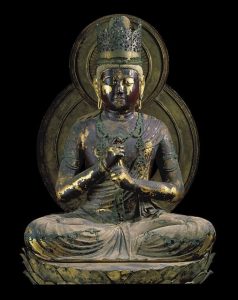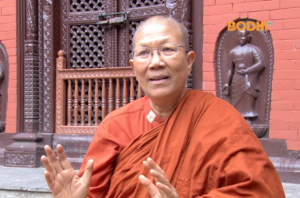
What do you imagine when you think of a bird? Perhaps its capacity to fly, to be borne above the ground, to cross oceans without touching water, and to soar through the sky. The bird is a symbol of pure freedom, carried aloft by nothing but its feathers and the air in its bones. The bird only touches the ground when necessary, to feed on worms when it’s unable to catch a cricket in the air. It wields only its keen, attentive vision, spotting prey from a great distance before swooping in. Thus birds can make us think of freedom, limitlessness, swiftness, and careful awareness.
Now, imagine a bird that hatches from its egg fully grown, shining like the sun, and that, when it flaps its wings, tornadoes are created! For sure this being has an immense life force. And using this power it can cut the air with its sharp wings; it sees the whole world and is aware of every movement of every being. It understands the nature of men and beasts alike because parts of its body resemble those of a human and other parts of a bird. This being is called the Garuda. It is a mythical bird-like entity that embodies pristine awareness. The Garuda exists within us, and is felt through the qualities of freedom, bravery, justice, swiftness, and awareness.
Of course, we don’t know which came first: the Garuda or the egg. This is a puzzle that the intellect will never solve. But when we create the Garuda in art, we are creating an image that represents and evokes all that naturally exists within us. We are fundamentally free: one does not need to obtain anything in order to be free. Quite the contrary, we need to let go of anger, attachments, and ignorance, and make our being as light as a feather, shining like a phoenix fearlessly crossing the sky—unstoppable, fearless, graceful, and aware of the whole world below and above.
The beautiful image of the Garuda is found in various spiritual and cultural traditions, depicted in various styles in Hinduism, Jainism, and Buddhism, and probably in many other contexts with different connotations. We cannot date how old this image is, but from the beginning of the universe, Vishnu, who maintains order, rides a Garuda. The Garuda’s body can grow to cover the whole sky or shrink to the size of a canary. Most of the time, the Garuda appears with the body of a bird with a human torso, yellow hair standing like fire, strong claws, and eating poisonous snakes, he is an enemy of nagas, despite sharing the same father.
There’s an interpretation I enjoy which says that the Garuda devours snakes and swallows the poisons of delusion, jealousy, and hatred, and then is able to transform them into renewed strength, illuminating his body and stretching his wings even more to soar into space. Therefore the Garuda is believed to provide protection against snake bites and many other illnesses, especially those caused by poison or magic, since nagas are often said to cast spells on other beings.
In Tibetan Buddhism, the Garuda is seen as a protective image decorating doorways and talismans. We can also see the Garuda as one of the four dignities—the four creatures representing the qualities of lungta, the windhorse, one for each cardinal direction: Garuda in the north; Snow Lion in the east; Tiger in the south; and Dragon in the West (in some regions, the directions may change). They are commonly depicted on lungta prayer flags, which flutter in the wind in high places so that the prayers written on them can be spread to the whole world. The Garuda is also a yidam, especially in the Nyingma school of Tibetan Buddhism, which prescribes important specifications about his color and implements so that the practitioner can visualize the Garuda completely. To practice Black Garuda or Red Garuda visualization, one must seek the proper initiation from a qualified teacher.

But what interests me most, and what I find so fascinating, is how certain traditions know how to employ symbolism and imagery as a bridge to the invisible. The stories and characteristics of a creature like the Garuda are also a reminder of our own buddha-nature, of the cultivation of bodhicitta, and of how we can see ourselves in a fantastic way in the pursuit of nirvana. For example, the power of the Garuda to be able to resize himself to match the sky or a grain of sand connects me to the notion of the nature of interbeing: all things are within me and I am within all things. If I want to know about the world, I should look into myself and if I want to understand myself, I should look into the world. The beautiful poem by Thich Nhat Hanh describes this wonderfully:
“Interbeing”
The sun has entered me.
The sun has entered me together with the cloud and the river.
I myself have entered the river,
and I have entered the sun
with the cloud and the river.
There has not been a moment
when we do not interpenetrate.
But before the sun entered me,
the sun was in me—
also the cloud and the river.
Before I entered the river,
I was already in it.
There has not been a moment
when we have not inter-been.
Therefore you know
that as long as you continue to breathe,
I continue to be in you.
Understanding that everything is within me and that I am within all things is the ability to live without the sensation of separation, which makes us live the “small” versions of ourselves. Being the Garuda is the limitless ability to move around the skies and for the skies to move inside me. This is the meaning of limitless. And yet the Garuda still needs two wings to fly, so even being inseparable from all things, we must move in this world of duality. In absolute reality there is no separation, but in the relative reality where the minds of human beings dwell in duality, we can navigate using one wing of compassion and one wing of wisdom, which together can carry us to nirvana.
When we move in the world with this clarity, fearlessness arises. There is no desire chaining you as you fly across the sky, which is your own mind. But when we desire freedom, we separate it from ourselves, placing it in the distance, and then we need “things” to reach it. For example, we think we need someone, or more money, or status, or a car in order to be free. And while you can have things and have the external experience to fly around the world, the habit of clinging to those things because you “need” to be free turns into a its own prison—desire will always chain you and it is a tyrannical master. It is so easy to live two distinguished lives: one within and one without. Actually, it is the most common life: two lives. In one life you can be the richest person in the world, possessing all the gold, but the inside is very poor and unsatisfied, and likewise the opposite can happen too. This is one of the strongest aspects of duality and so difficult to dissolve.
The following excerpt from a famous poem by Khalil Gibran describes how we confuse freedom and desire.
“On Freedom”
In truth that which you call freedom is the strongest of these chains, though its links glitter in the sun and dazzle your eyes. . . .
For how can a tyrant rule the free and the proud, but for a tyranny in their own freedom and a shame in their own pride?
And if it is a care you would cast off, that care has been chosen by you rather than imposed upon you.
And if it is a fear you would dispel, the seat of that fear is in your heart and not in the hand of the feared.
We must look within to see whether our desire to be free is instead actually imprisoning us.
There is a Zen story about a master and his disciple walking peacefully along a small path in a forest. The disciple began to complain about how the world distracted him, and how all his responsibilities bound him to serve samsara, and how he longed to be free—if only these duties did not exist he would be free.
The master said no word and they continued walking in silence.
Suddenly the master ran madly and wrapped his arms around a tree, screaming, “Let me be free! Let me be free!” The disciple, immensely confused, spoke out: “Master, just open your arms, no one is restraining you!” Immediately the master opened his arms, smiled and continued his peaceful walk.
The disciple then attained realization.

We are the prison and we are the sky; the vastness of being is so infinite that it accommodates freedom and imprisonment. It really depends on how we look at life. It’s the same as a boy carrying a huge bag of food to his family living up in the hills. A man approaches the boy and exclaims, “What a burden to be carrying such a big weight!” The boy replies, “It’s not a burden, it’s food.” So when you see the wings of a Garuda, remember the limitlessness of your being. When you see a Garuda’s bulging eyes, remember its clear and panoramic vision in the pure awareness of being.
The bird is an incredible symbol in the traditional Buddhist teaching of the fundamental importance of compassion combined with wisdom. This is repeated in many other images, such as the yab-yum (the union of two deities), and in the vajra and dorje combined. But the Garuda is always accompanied by snakes, a being of singular shape, moving without legs or wings, just a body; possibly a reminder of union and non-duality. When the kundalini is awakened, it is represented by a standing snake, as if it were a single channel of flowing energy. A non-dual representation of raised energy on the top of the head has been represented not only in Buddhism and Hinduism—even Cleopatra of Egypt wore a crown with a cobra head in the center.
When the Garuda crosses the sky, flapping his two wings and bearing a snake in his beak, it reminds me that even passing through life attending to my duties, I carry within me the potency of non-duality and, as contradictory as it might seem, I thus know I can experience attachment and freedom, I can experience anger while within my heart a calm sea is reflected. I can be a bird in the sky and a snake lying flat with its whole body upon the ground. I can be both. And I should not think that I need to be free of attachment when I am attached, but to be able to see with the eyes of a hawk the sky of attachment from where it was born and where it will dissolve.
Just as the Garuda and the Naga share the same father, have similar blood, have the same origin, they arise from the same place and in the same space they dissolve. Attachment and freedom, anger and peace, ignorance and wisdom might just have the same source, simply different aspects of the same thing.

A light heart is needed to enter heaven, and in Egyptian mythology a feather is used to weigh the heart before being admitted to heaven. Again, the bird represents lightness and free access to the sky, or heaven. What does it mean to you to a have a heart as light as a feather? Can you ride on the back of freedom? Can you be a Garuda and a Naga? Sky and ground? Anger and peace at the same time? The same space which accommodates the sun is also open to storms. The Garuda is a symbol of totality, of authentic expression, of a being who is born fully grown . . . beyond time and space. When you see the Garuda, remember your totality and your inseparability from all things, and smile—nothing is constraining you.
* Drawings from the online course “Drawing the Myth of the Garuda,” which I taught through Yangchenma Arts & Music.
See more
Tiffani Gyatso
Yangchenma Arts & Music
Related features from BDG
Life Is Not Useful
Opening to Beauty
Thinking Is a Skill. But Someone Else Figured it Out Before You












